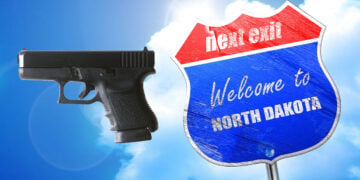Shot placement and grip are not related. As long as the trigger is pulled, the bullet doesn’t care how your hand grips your gun. That said, for fast follow-up shots, tight shot placement, etc., grip does come into play.
No concealed carrier plans on taking down his target with the first round. We always strive to make that first round on target – but no guarantees on efficacy.
Pistol Grip – High Or Low?
The pistol grip is generally how we control the firearm. After a shot is fired, the upper receiver slaps backwards – generally giving us the impression of recoil. The lower a person grips a pistol, the more that force becomes angular. Fast follow-up shots depend on that force being as close to a straight line as possible.
Danger Signs That Grip Is Too High
- The webbing of your dominant hand is getting bit by the upper receiver after a round is fired.
- Supporting fingers along the upper receiver are getting bit by the slide
Having a too high of a grip can definitely hurt. The hard part for a lot of shooters is that the higher the grip, the more stable the recoil and tighter the follow-up shots. But there’s also a real risk of having too low of a grip.
Danger Signs That Grip Is Too Low
- You have a hard time getting back on target after the initial shot – due to recoil.
- Your trigger pull naturally cants the muzzle below the bullseye.
Too high and your hand is getting bit. Too low and the gun is not in your control. This is why range time and dry firing are essential to finding the right grip for the gun. Each firearm will have different requirements as concealed carry pistols typically range from barely enough space for one hand all the way to needing both to direct the firearm.
Read Also: Common Handgun Shooting Problems, Probable Causes, and Possible Solutions
Isometric Tension – Supporting The Gun From All Angles
In order to reduce recoil and weapon spread, you need to apply uniform pressure along the gun. This helps to compensate for any recoil and ensures follow up shots are placed tightly and precise with the previous. The hard part? Our hands aren’t perfect vice grips. And different pistol grips (and revolver grips) require different hand configurations. The one technique that’s unilaterally ineffective is the tea cup grip. That’s where your dominant hand maintains a firm middle grip of the pistol and your supporting hand rests beneath the magazine well.
Here’s a short video that reasonably shows a good technique for Glock-style pistol grips.
For revolvers (and especially compact J-frames), The Yankee Marshall has a very decent video demonstrating grip.
“But wait a second, USA Carry, you just said the teacup grip was a bad idea and Yankee Marshall is saying it’s a good one.”
For small J-frame revolvers, you can get away with a tea cup grip. Heck, for many shooters, J-frame revolvers are solo-hand carry firearms. Revolvers are awesome and unfortunately have taken a back seat in the world of high speed, low drag polymer designs and fancy gadgetry. But there’s plenty of reasons why revolvers are still on the market – and if you’ve got smaller hands and really want to make sure that first round strikes along your sight alignment – a J-frame is definitely worth checking out.
In the end, there’s no one grip fits all approach to firearms. Preferably, grip as high as you can without snapping your fingers or hands. Keep your finger clear and off the trigger until you’re ready to fire. And above all else, experiment at the range so you don’t have to experiment in real life.









